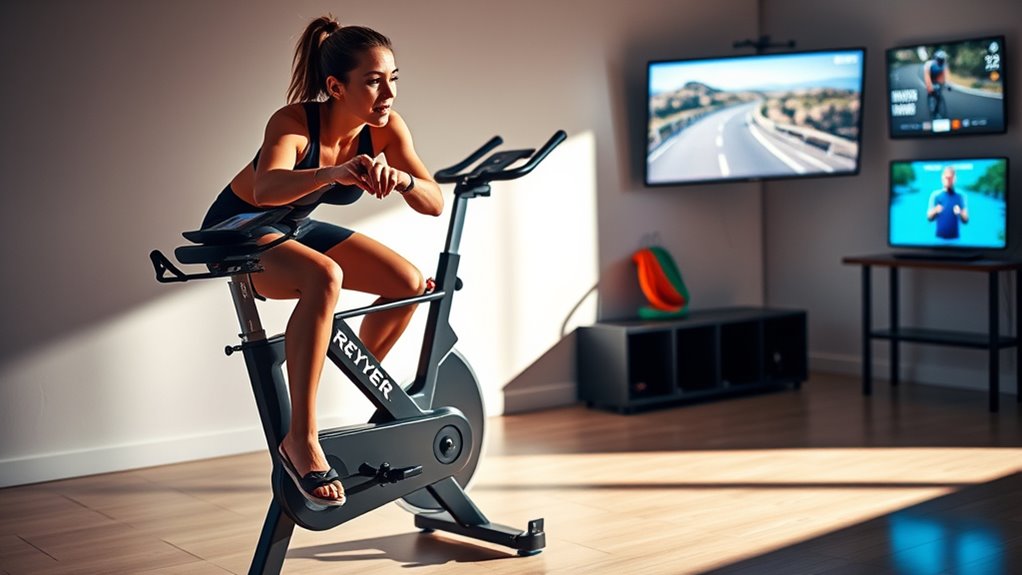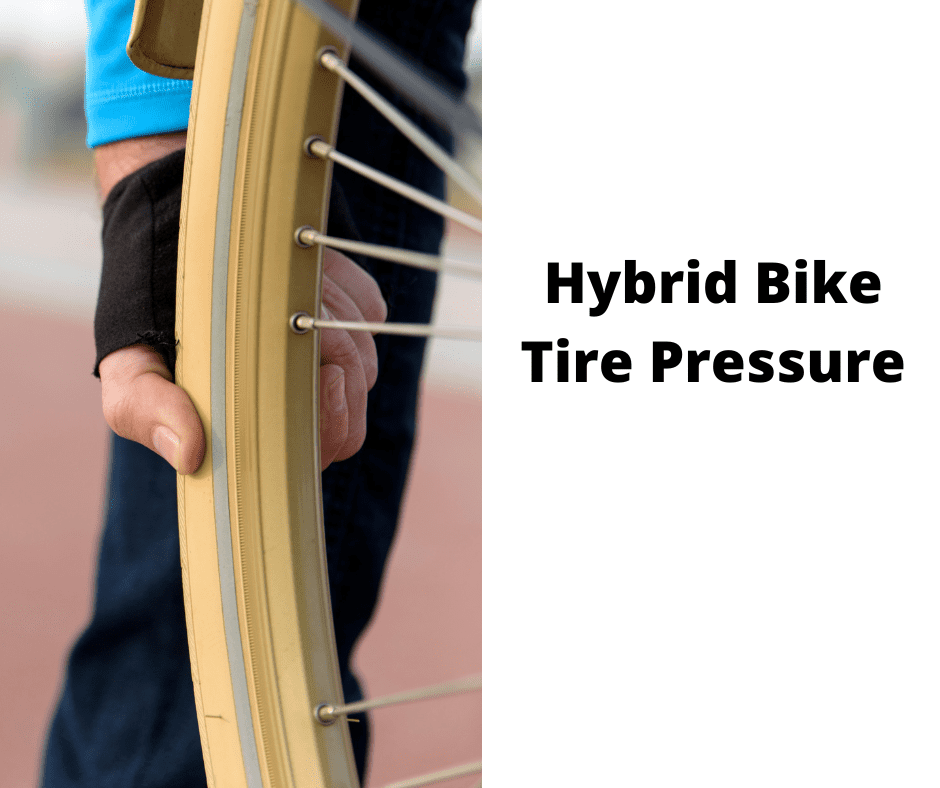To boost your speed and endurance at home, focus on a mix of aerobic workouts and interval training. Incorporate steady-state rides to build stamina and include speed intervals for power. Warm up for 10-15 minutes to prevent injuries and cool down afterward to enhance recovery. By challenging your lactate threshold during intervals, you’ll maximize your performance. Keep pushing your limits, and you’ll discover more effective strategies to elevate your cycling game.
Key Takeaways
- Incorporate Speed Intervals, alternating 30 seconds of intense effort with 30 seconds of recovery, to enhance your cycling speed at home.
- Utilize Aerobic Tempo workouts, cycling for 3 x 15 minutes at 80-90% heart rate, to build endurance effectively.
- Engage in Sweet Spot Tempo sessions, performing 2 x 20 minutes at 88-94% heart rate for sustained power output.
- Implement steady-state rides at 68-75% threshold heart rate for longer durations to improve overall endurance and Functional Threshold Power.
- Don’t forget warm-ups and cool-downs; they prepare your body for training and aid in recovery, reducing injury risks.
Understanding Aerobic Endurance in Cycling

How can understanding aerobic endurance enhance your cycling performance? By focusing on aerobic endurance, you improve your body’s ability to use oxygen efficiently, essential for long rides.
Training below the lactate threshold helps you avoid fatigue while effectively challenging your aerobic system. Spend most of your training time on Zone 2 rides to boost your aerobic capacity without overwhelming yourself.
Training in Zone 2 enhances aerobic capacity while preventing fatigue, making it key for effective cycling performance.
Consistent workouts, like Aerobic Tempo and Sweet Spot sessions, should be part of your routine 2-3 times a week to maximize time-at-intensity and promote long-term gains. Incorporating whole foods into your diet can further support your energy levels during these intense training sessions.
These sessions increase mitochondrial density and capillarization, enhancing muscle fiber efficiency and oxygen delivery, ultimately leading to better cycling performance and endurance training.
Embrace this approach, and watch your cycling improve!
Key Workouts for Improving Speed and Stamina
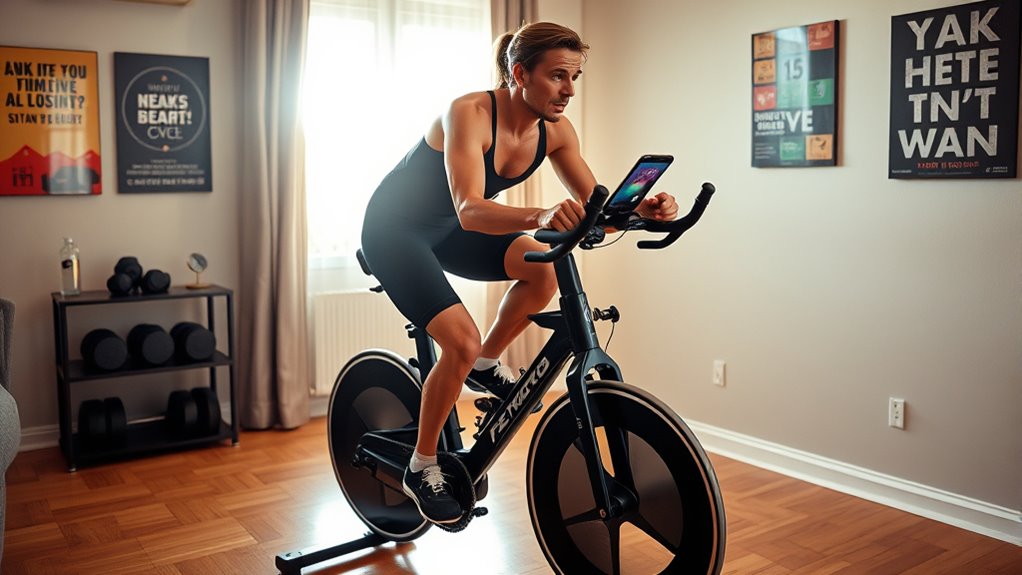
To improve your cycling speed and stamina, incorporating a variety of targeted workouts is essential.
Start with Speed Intervals, pushing for 30 seconds at efforts 20% above your lactate threshold, followed by 30 seconds of recovery.
Add Aerobic Tempo workouts, like 3 x 15 minutes at 80-90% heart rate with 5 minutes of rest, to build endurance.
Sweet Spot Tempo sessions of 2 x 20 minutes at 88-94% heart rate will increase sustained effort duration.
Don’t forget Flying 40s—40 seconds of hard pedaling in a medium gear, then 20 seconds of recovery—to develop power.
Finally, engage in Hill Charges on a moderate incline to boost climbing strength and overall cycling capability. Proper cycling gear can also enhance your efficiency and comfort during these workouts.
The Role of Interval Training in Home Workouts
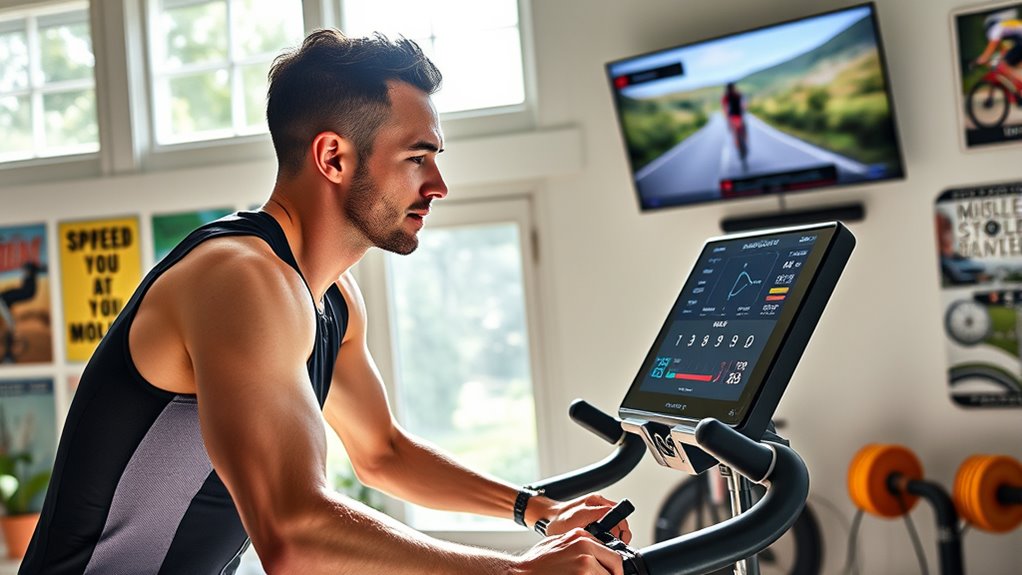
Building on the variety of workouts that enhance speed and stamina, interval training emerges as a powerful tool for cyclists looking to maximize their home workouts.
By alternating high-intensity efforts with recovery periods, you can boost both speed and endurance effectively. High-intensity interval training (HIIT) improves your VO2 max and lactate threshold, allowing you to sustain higher power outputs over time.
Structured interval sessions, like 30-second speed intervals followed by equal recovery, enhance your leg snap and overall performance without needing outdoor rides. Monitoring your power output during these sessions, aiming for at least 20% above your lactate threshold, guarantees you’re getting the most out of your cycling workouts.
Embrace interval training for significant fitness gains in a controlled environment. Additionally, staying properly hydrated is essential for preventing fatigue during these intense workouts.
Incorporating Steady-State Rides for Endurance
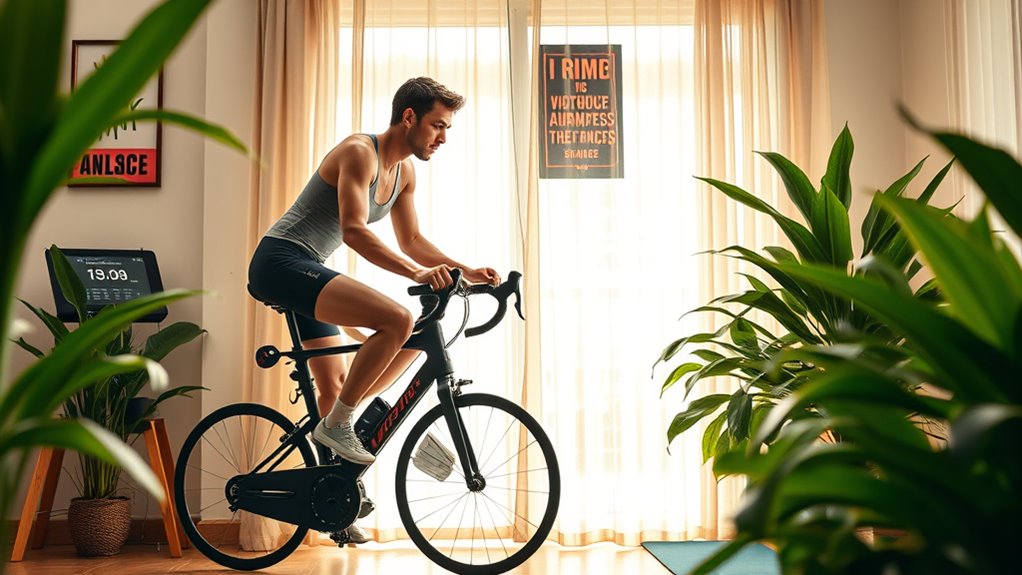
While many cyclists focus on high-intensity workouts, incorporating steady-state rides into your routine is essential for building endurance.
These rides maintain a constant pace at moderate intensity, typically around 68-75% of your threshold heart rate, effectively boosting your aerobic endurance.
By focusing on longer durations, like 2.5 hours in the endurance zone, you can greatly improve your Functional Threshold Power (FTP) and sustain higher power outputs over time.
Focusing on longer steady-state rides boosts your FTP, enabling you to sustain higher power outputs effectively.
Steady-state rides also enhance recovery and support cardiovascular health by promoting blood circulation.
Plus, they’re versatile—you can perform them indoors or outdoors, ensuring consistent training regardless of weather conditions.
Integrating these rides into your training routine will help you become a stronger, more resilient cyclist. Additionally, maintaining proper gear shifting techniques during your rides can further enhance your efficiency and performance.
Importance of Warm-Ups and Cool-Downs

Warm-ups and cool-downs are crucial parts of any cycling workout, as they prepare your body for the effort ahead and help it recover afterward.
A warm-up typically lasts 10-15 minutes, gradually raising your heart rate and loosening muscles. Incorporating easy spinning during this time increases blood flow and reduces injury risk in your subsequent rides.
After your workout, a cool-down is essential for returning your heart rate to normal and flushing out lactic acid, aiding muscle recovery and reducing soreness. Gentle pedaling and stretching during your cool-down can enhance flexibility.
Both warm-ups and cool-downs are integral components of effective training plans, contributing to improved performance and injury prevention for your cycling journey. Additionally, just as a home cinema benefits from color accuracy, ensuring your body is adequately prepared can enhance your overall workout experience.
Tips for Staying Motivated While Cycling Indoors
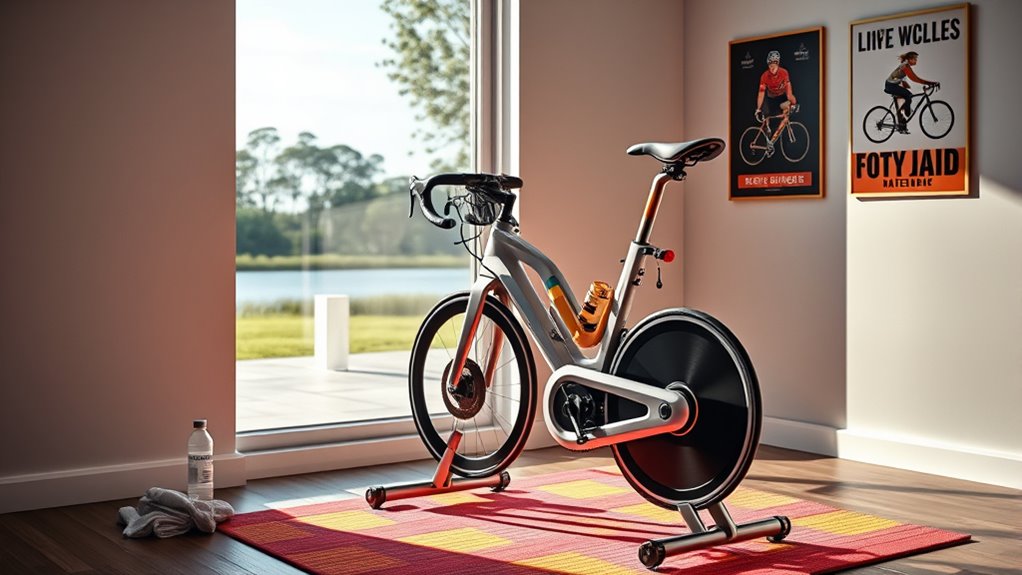
Staying motivated during indoor cycling can be a challenge, especially when you’re riding in the same space repeatedly. To keep your energy high and your focus sharp, try these tips:
- Set Specific Goals: Choose fitness goals for each session, like increasing duration or intensity, to track progress effectively.
- Mix Up Your Workouts: Incorporate various workout types, such as interval training and steady-state rides, to keep your sessions engaging and target different fitness aspects.
- Create a Motivating Environment: Use cycling apps or music playlists to enhance your experience and connect with others. Additionally, incorporating mindfulness techniques can help maintain focus and reduce distractions during your workouts.
Frequently Asked Questions
How Do I Increase My Speed in Cycling?
To increase your speed in cycling, incorporate speed intervals into your routine.
Try 30-second accelerations followed by 30 seconds of recovery to enhance your leg power. Focus on high cadence efforts, aiming for 90-110 RPM during sprints.
Don’t forget hill charges; standing out of the saddle for 30 seconds on inclines builds leg strength.
Also, add Tabata intervals, sprinting for 20 seconds followed by a brief rest, to boost your overall power output.
What Is the 80% Rule in Cycling?
The 80% Rule in cycling means you should spend about 80% of your training at low to moderate intensities.
This approach helps build your aerobic endurance and creates a solid fitness foundation.
Only 20% of your training should involve high-intensity efforts, which are essential for improving speed.
How to Increase Endurance in Cycling?
Think of your endurance as a river, flowing stronger and wider over time.
To increase it in cycling, you need to incorporate longer rides at 68-75% of your threshold heart rate, gradually extending your time on the bike.
Add interval training sessions to challenge your limits and include zone 2 rides to build a solid foundation.
Consistency is key, so make sure you’re regularly pushing your boundaries to see significant gains.
What Is the 75 Rule in Cycling?
The 75 Rule in cycling suggests you should spend at least 75% of your training in aerobic zones. This means focusing on low-intensity rides that keep you below your lactate threshold, which builds a strong endurance base.
You’ll improve your aerobic capacity without overdoing it. The remaining 25% of your training can include higher intensity work, like intervals, to enhance your speed and power.
Balancing these elements is key for peak performance.
Conclusion
By integrating these key workouts and techniques into your home cycling routine, you’ll see your speed and endurance soar like a kite catching the wind. As you warm up and cool down, picture yourself gliding effortlessly on the road, heart racing with each interval. Remember to stay motivated, just like a flame flickering in a cozy fireplace. With dedication and consistency, you’ll transform your indoor sessions into a powerful journey toward cycling success. Keep pedaling forward!
